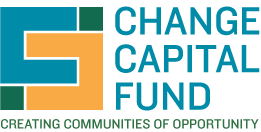|
CCF Grantees Consider Collective Impact Approach
Change Capital Fund recently hosted the Philadelphia Youth Network (PYN) and JEVS Human Services for an information session about how their Project U-Turn used a collective impact approach to decreased high school drop-out rates by almost 50% over ten years. PYN is a self-described ‘backbone organization’ that convenes a 30-member partnership that includes nonprofits, policy organizations, employers, and key City agencies. JEVS Human Services is one of the organizations that works with PYN. Recognizing that it takes more than siloed, single-purpose programs and efforts to lead individuals, families and communities out of poverty, CCF grantees have, like PYN, been building purposeful networks, evolving a model of community development that is more collaborative, integrated and data-driven. With Change Capital, they are building their capacity to coordinate both internal departments and external partners and to use data to monitor progress and hold partners accountable to shared outcomes. PYN’s Role: Collaboration Benefits:
CCF Grantees Collective Impact Approach:
CCF grantees are increasingly borrowing from the lessons of collective impact. For example, Cypress Hills Local Development Corporation (CHLDC) is the backbone organization for their Promise Neighborhood effort. In the absence of federal funds, CHLDC used part of their CCF grant to hire a Promise Coordinator who has been convening partners to improve referrals, coordination and data sharing strategies. During the planning process, CHLDC convened over 40 organizations, schools, intermediary and policy organizations, local government offices, and residents, to support their ongoing work to build a cradle-to-college continuum of solutions for young people in their neighborhood. The process included five working groups: 1) School Readiness; 2) K-12 Education and College Access; 3) Health and 4) Community Life and Safety; all informed by their intensive community engagement process. As part of the planning process, CHLDC collected over 850 surveys from local residents, held a community forum, attended by over 150 local residents and facilitated seven focus groups. Unlike PYN, CCF grantees are providing direct services, which informs their perspective and provides credibility with partners. Their assumed roles of coordinator, facilitator and data manager are not generally resourced by government contracts. To fully realize the potential of this approach, they require increased partnership with government and resources to support the backbone role. We hope to see more of this type of financial support in the future. |
|
|
Investing in What Works for America’s Cities
The Investing in What Works for America’s Cities blog recently posted a piece about the CCF initiative penned by CCF Donor Member Eileen Auld, NY Tri State Market Director of Citi Community Development. Ms. Auld outlines the promises of the CCF initiative in helping community organizations advance the fight to help more individuals, families, and communities build wealth and climb the economic ladder. You can read the piece here. |
|
|
|
Grantee News
Community Solutions/Brownsville Partnership: The 5,000 Jobs Campaign recently brought together seven key workforce development partners to map out this program’s user experiences. The Brownsville Partnership identified common problems, bright spots, and opportunities for greater connectivity and integration among partners. It also gave the organization a clearer view of the collective hurdles to seeing more Brownsville residents successfully enter the workforce,
including affordable childcare, a lack of basic work skills, and the struggle among long-term unemployed people of maintaining the confidence to stick with training programs and the interview process.
In the coming weeks the Brownsville Partnership will work with individual partner programs to address these key pain points that lead to program attrition. The Brownsville Partnership will also help these programs pilot specific interventions that will lead to stronger program retention, graduation, and job placements rates for Brownsville job seekers. St. Nicks Alliance: This month, St. Nicks Alliance launched the BK Story Voyager, an innovative multimedia mobile book library that serves as a flagship program of ST. Nicks NABE 3.0 program. The BK Story Voyager was created to improve literacy among elementary school students living in North Brooklyn. The book mobile is scheduled to make bi-weekly visits throughout the year to eight St. Nicks Alliance after school and community centers and will offer a specially designed curriculum and programs to children.
St. Nicks also received a $75,000 grant from The Pinkerton Foundation to launch an intensive literacy immersion initiative, including the book mobile, that integrates school, family, and community in an effort to increase the number of children in North Brooklyn who read at or above grade level and have a greater likelihood of completing middle school and high school.
New Settlement Apartments (NSA): This school year, NSA’s Communities for Healthy Food, a program that works with elementary school campus PS 64 to advance wellness and improve food options, developed a new partnership with Wellness in the Schools(WITS). WITS inspires healthy eating, environmental awareness, and fitness as a way of life for kids in public schools. The WITS coach transformed recess from a time of sedentary socializing to a time for activity and teamwork. And the school’s 900 students are now eating fresher and less processed foods.
In early February, as part of an effort to engage parents, NSA sponsored the first annual Family Fitness Fun Night through WITS. Over 150 children and parents attended. To further their wellness initiative, NSA also partnered with FoodCorps, which is giving students hands-on gardening and cooking classes. These are just two of many NSA initiatives to improve the health of local residents. |
|
|
|
Donor News
Citi Foundation announces $4.8 million investment in Summer Jobs Connect to jumpstart career readiness of more than 2,000 youth. The New York Community Trust announces $7.9 million in grants for nonprofits in NYC and across the nation. The New York Foundation partnered with StoryCorps to craft interviews featuring trustees, grantees, and former grantees in conversations that get to the heart of what matters in their work. Enterprise‘s Judi Kende writes in City Limits about An Investment in Opportunity, a bold new vision for housing policy in the United States. |





